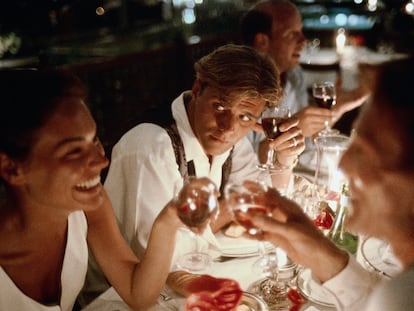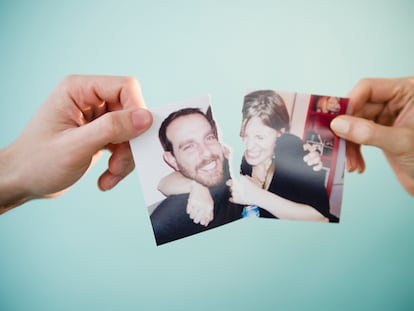What is the relationship between love and sex?
Anthropologists have suggested that, in humans, sexual attraction evolved into romantic feelings to foster the desire to stay together

Charles Darwin was obsessed with the peacock’s tail. His theory of natural selection simply did not explain how such a trait, which looked more like an awkward hindrance than an adaptive advantage, could have evolved. However, his naturalistic genius also made him realize that in order to achieve a successful selection, there must be plenty to choose from. In other words, nature must have the greatest possible number of variations in the different traits of all kinds of animals. This range – he did not take long to discover – is provided by sex selection, the mate selection mechanism that makes individuals of one gender develop evolutionary characteristics to attract members of the opposite sex.
Thus, the more ostentatious and full of eyespots the male peacock’s tail is, the greater sexual arousal and attraction the females will feel towards him; and the more eyespots, the better health and reproductive capacity those males have too. Therefore, when a female picks a tail with an abundance of eyespots, what she is actually doing is unknowingly selecting a male that will guarantee a healthy offspring, with the capacity to survive.
Do humans have any similar choice mechanisms? It seems that way. At least one, since men of practically all cultures feel particularly attracted to a female figure with a waist-to-hip ratio of 0.7 (7%). Some call it the hourglass body shape. If that ratio is maintained, the weight of the woman’s body doesn’t matter much, as 0.7 seems to have always been the ideal shape from the male perspective.
Examples of this can be found throughout history, from classic paintings and sculptures to prototypes of the divas of the golden age of Hollywood and also women today, when such a body shape prevails. Over time, only the exemplary assessment of female body weight has changed (downward; in the past, the ideal female body did not have the reckless thinness of many current stereotypes), but not that of its shape.
Even though some data indicates that women with a waist-to-hip ratio of 0.7 might have a lower prevalence of conditions such as cardiovascular diseases or cancer, other factors like smoking, pollution and stress have altered this potential reality, making some women who have different body proportions, but who take better care of themselves, healthier than those with an hourglass body. In any case, the natural mechanism seems to be still in place, and men continue to be captivated by that body shape. Like the female peacock, human males also seem to be unwittingly choosing reproductive potential. Similar mechanisms also seem to exist in the opposite direction, from women to men, but they have not been as studied.
But then, where is the love? Anthropologists such as the renowned Helen Fisher have suggested that, in humans, sex-based attraction evolved into romantic or passionate love, a form of union that, from an evolutionary perspective, tends to guarantee the stability of the couple to secure parental care of offspring. Love, in this context, is constituted as a feeling, a social and conscious emotion that implies not only lust, but also passion and a bond between the members of the couple.
The brain of people in love causes physiological reactions and releases chemicals in order to create that feeling. On one hand, it induces the gonadal production of hormones like the male androgens or the female estrogens, which increase sexual desire. In the initial stage of romantic love, the brain also produces stimulating substances like phenylethylamine and dopamine, which induce a state of euphoria, motivation and passion. Sexual intercourse also causes the release of hormones like oxytocin and vasopressin, which foster the desire to stay together.
The initial passion, especially in young lovers, is also characterized by the inhibition of brain substances like serotonin, mood stabilizers, or the deactivation of brain regions like the frontal cortex, involved in logic and reasoning. Maybe that is why they say that love is blind.
On the other hand, love and sex are different in that one can occur without the other, and although both types of motivation – love and sex – demand urgent satisfaction, the sexual one is usually relieved with intercourse, while love can last for many years. But, alas! Love changes with time. The initial intensity and passion give way to a more mature love, a calmer, more consistent emotion, with the brains of lovers secreting different substances, such as endorphins and enkephalins, which induce less passionate states of relaxation, satisfaction and well-being. Such substances also have a more addictive nature that makes it more difficult to overcome a separation or the loss of a loved one.
In conclusion, although different and, in a way, independent, love and sex are evolutionarily related by being synergistic in relation to successful reproduction and by functioning in practice with a high level of connection that generates an important and beneficial mutual influence. Happy Valentine’s Day to all those in love.
Sign up for our weekly newsletter to get more English-language news coverage from EL PAÍS USA Edition
Tu suscripción se está usando en otro dispositivo
¿Quieres añadir otro usuario a tu suscripción?
Si continúas leyendo en este dispositivo, no se podrá leer en el otro.
FlechaTu suscripción se está usando en otro dispositivo y solo puedes acceder a EL PAÍS desde un dispositivo a la vez.
Si quieres compartir tu cuenta, cambia tu suscripción a la modalidad Premium, así podrás añadir otro usuario. Cada uno accederá con su propia cuenta de email, lo que os permitirá personalizar vuestra experiencia en EL PAÍS.
¿Tienes una suscripción de empresa? Accede aquí para contratar más cuentas.
En el caso de no saber quién está usando tu cuenta, te recomendamos cambiar tu contraseña aquí.
Si decides continuar compartiendo tu cuenta, este mensaje se mostrará en tu dispositivo y en el de la otra persona que está usando tu cuenta de forma indefinida, afectando a tu experiencia de lectura. Puedes consultar aquí los términos y condiciones de la suscripción digital.
More information
Archived In
Últimas noticias
Welcome to the post-religion era: The idea of Christianity as the absolute truth has become obsolete
‘I thought you would like it’: The risky sexual practice popularized by TV shows and TikTok
The digitalization of tourism: ‘They promise experiences and gave us the worst possible one’
Mexican peso defies uncertainty with forecasts of a new period of stability in 2026
Most viewed
- Sinaloa Cartel war is taking its toll on Los Chapitos
- Reinhard Genzel, Nobel laureate in physics: ‘One-minute videos will never give you the truth’
- Oona Chaplin: ‘I told James Cameron that I was living in a treehouse and starting a permaculture project with a friend’
- Why the price of coffee has skyrocketed: from Brazilian plantations to specialty coffee houses
- Silver prices are going crazy: This is what’s fueling the rally











































